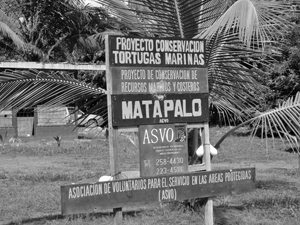TURTLE PROJECT – MATAPALO BEACH
By Katherine Richardson
 The ASVO (Association of Volunteers) has been in Matapalo Beach for 5 years and patrols 5.4 KM of the beach. Olive Ridley (Lepidochelys olivacea)turtles nest on Matapaplo Beach from June to November. This year according to Mr. Roberto Solano, the scientist in charge of the project, they have had 180 Olive Ridley turtle nests and on 1 leatherback nest as of the 10th of Dec. This is the first leatherback nest in the past 5 years of monitoring according to Mr. Solano. The Volunteers conduct night patrols, monitor the turtle hatchery 24 hours a day and clean up the beach in Matapalo. Night patrols continued until mid December to protect the nests from poachers and retrieve the eggs to the safety of the hatchery. Hatchings will continue through January.
The ASVO (Association of Volunteers) has been in Matapalo Beach for 5 years and patrols 5.4 KM of the beach. Olive Ridley (Lepidochelys olivacea)turtles nest on Matapaplo Beach from June to November. This year according to Mr. Roberto Solano, the scientist in charge of the project, they have had 180 Olive Ridley turtle nests and on 1 leatherback nest as of the 10th of Dec. This is the first leatherback nest in the past 5 years of monitoring according to Mr. Solano. The Volunteers conduct night patrols, monitor the turtle hatchery 24 hours a day and clean up the beach in Matapalo. Night patrols continued until mid December to protect the nests from poachers and retrieve the eggs to the safety of the hatchery. Hatchings will continue through January.
 The Coast Guard also helps to protect the nests from poachers and when caught will take the eggs from them. The eggs are thought to help with fertility and can bring between 250-500 colonies each. Once a nest is found and the eggs retrieved a radio call to the hatchery begins the construction of a nest for the eggs. Incubation is between 45 -60 days and a nest will have between 33 to 150 eggs. Average nests hatch around 80 to 100. The female turtle lays several nests per season. The hatchery provides a safe haven for the eggs with 24 hr monitoring, keeping them from predators (monitored every 15 mins.) such as ants and crabs, and to prevent the hatchlings from burning up in the sun. The turtle nest usually hatch at night, but can hatch at any time. Often after it rains, the sand is cooler and the baby turtles think it’s night. Nests which hatch the night before are usually exhumed at around 3 or 4 PM and then released. Only female sea turtles return to the shore to lay their eggs after reaching maturity at 20 years of age. The male turtles never return to shore. Only 1 in a 1,000 turtles survive to adulthood.
The Coast Guard also helps to protect the nests from poachers and when caught will take the eggs from them. The eggs are thought to help with fertility and can bring between 250-500 colonies each. Once a nest is found and the eggs retrieved a radio call to the hatchery begins the construction of a nest for the eggs. Incubation is between 45 -60 days and a nest will have between 33 to 150 eggs. Average nests hatch around 80 to 100. The female turtle lays several nests per season. The hatchery provides a safe haven for the eggs with 24 hr monitoring, keeping them from predators (monitored every 15 mins.) such as ants and crabs, and to prevent the hatchlings from burning up in the sun. The turtle nest usually hatch at night, but can hatch at any time. Often after it rains, the sand is cooler and the baby turtles think it’s night. Nests which hatch the night before are usually exhumed at around 3 or 4 PM and then released. Only female sea turtles return to the shore to lay their eggs after reaching maturity at 20 years of age. The male turtles never return to shore. Only 1 in a 1,000 turtles survive to adulthood.
 Once hatchlings are retrieved from the nest 10 from each nest are weighed and the length of the shell measured and recorded before releasing. The scientists at the facility are very informative & passionate about sea turtles & their enthusiasm for their work is contagious. Volunteers come from all over the world to participate. This year they came from Germany, Great Britain, Australia, Spain, Switzerland, Scotland, United States, Thialand and Costa Rica.
Once hatchlings are retrieved from the nest 10 from each nest are weighed and the length of the shell measured and recorded before releasing. The scientists at the facility are very informative & passionate about sea turtles & their enthusiasm for their work is contagious. Volunteers come from all over the world to participate. This year they came from Germany, Great Britain, Australia, Spain, Switzerland, Scotland, United States, Thialand and Costa Rica.
The Olive Ridley is endangered. They are threatened by poachers, pollution in the water including plastics, fishing line(causing entanglement and drowning) from shrimp nets and long line, the loss of habitat due to beach development including hardening of shoreline(seawalls) and possibly global warming causing the sea water temperature to raise. They feed on shrimp, fish, crabs, and other small animals including jelly fish. The Olive Ridley inhabits tropical waters of the Pacific, Indian & Atlantic Oceans. In Costa Rica, they live in the country’s Pacific waters. Unlike other sea turtles, female ridleys often emerge  together, by the thousands, to lay their eggs on beaches. This phenomenon is called arribada. In the past olive ridleys carried out their arribadas on dozens of Pacific coast beaches from Mexico to Panama. But today such emergences take place on just three: Playa Escobilla in Oaxaca, Mexico, and Playa Nancite & Playa Ostional in Costa Rica.
together, by the thousands, to lay their eggs on beaches. This phenomenon is called arribada. In the past olive ridleys carried out their arribadas on dozens of Pacific coast beaches from Mexico to Panama. But today such emergences take place on just three: Playa Escobilla in Oaxaca, Mexico, and Playa Nancite & Playa Ostional in Costa Rica.
To celebrate the turtle project and releasing a Turtle Festival was held on Matapalo Beach in late November with music, food, kite flying, surfing contests and much more fun.
 Quepolandia would like to thank Katherine Richardson of Manuel Antonio for contributing this information. Katherine and her 5 year old son, Garrett, were volunteers for 2 months of the project.
Quepolandia would like to thank Katherine Richardson of Manuel Antonio for contributing this information. Katherine and her 5 year old son, Garrett, were volunteers for 2 months of the project.

If possible, everyone should have the exhilleration of seeing these prehistoric creatures drag themselves from the sea by moonlight, and stand watch as they lay their eggs–and then that quiet moment one has, thinking that in 20 years, one of these teenie turtles might make their way back to this same spot again. A humbling, “bucket list” event.
Lordy I am one happy lady that I can read Quepolandia from home in New England now!! I LOVE LOVE LOVE you guys and can’t wait to party with everyone at Dos Locos in a couple of weeks. Sorry I’ll miss you at the Central Pacific Ladies Meeting, again.
Mary Jane Piazza
Richmond, MA
Portasol, Portalon